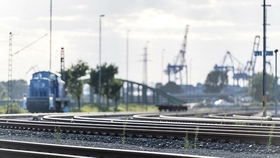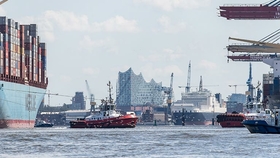
Elbe tour boats and port barges, speed boats and container ships: in the Port of Hamburg, there is a full range of working and pleasure vessels.
But how is this daily level of seagoing, inland, traditional and pleasure vessels coordinated? The smooth movement of traffic on the waterways in the port area is only possible if nautical safety is continuously ensured. Maintaining this safety is the task of the harbour master's division. We keep you informed about navigation routes and berths and advise vessel navigators from our nautical control centre.
Well cared for, well prepared: Firstly, the harbour master's division safeguards the constant safety of shipping through the use of navigation management measures, and where possible further improves these.
Moreover, the harbour master's division considers the preventive exercise of functions as its central task. This includes the early identification of disruptions in the maritime traffic and the implementation of appropriate measures.
These preventive measures not only increase safety, rather they make an essential contribution to the productivity of the Port of Hamburg.
All contacts from the field marine infrastrucutres are listed and pre-filtered for you.
| Pangritz, Sinje [Translate to English:] Head of Public Affairs / Press Officer | -1- | [Translate to English:] Ihr Ansprechpartner: |
Pangritz, Sinje
[Translate to English:] Head of Public Affairs / Press Officer
Neuer Wandrahm 4
20457
Hamburg
+49 40 42847-2301

|
| Dlugosch, Jan Shipping police approvals | -6- | Your contact: |
Dlugosch, Jan
Shipping police approvals
Oberhafenamt
Neuer Wandrahm 4
20457
Hamburg
+49 40 42 84 7-2575

|
| Pillkahn, Jens [Translate to English:] Leiter Servicecenter Railway Infrastructure | -4- | [Translate to English:] Ihr Ansprechpartner: |
Pillkahn, Jens
[Translate to English:] Leiter Servicecenter Railway Infrastructure
Hafenbahn
Veddeler Damm 14 a/b
20457
Hamburg
+49 40 42847-5570

|
| Port Dues Office | -42- | Port Dues Office |
Port Dues Office
+49 40 42847-5500

|
Here you can find all downloads from the section marine infrastructure prefiltered for you.
| Information Sheet concerning Notice of Arrival/Departure | -General Information- -Inland Waterway Shipping- | Information Sheet concerning Notice of Arrival/Departure | ||
| Port Information Guide 2021 | -General Information- -Brochures- -Port Shipping- -Maritime Shipping- | Port Information Guide 2021 | ||
| Port Information Guide 2023 | -General Information- -Brochures- | Port Information Guide 2023 | ||
| Port Information Guide 2022 | -General Information- -Instructions / Regulations- -Reports- -Brochures- | Port Information Guide 2022 | ||
| Port Information Guide 2020 | -Brochures- -General Information- -Guidelines- | Port Information Guide 2020 | ||
| Information Sheet concerning Notice of Arrival/Departure | -General Information- -Inland Waterway Shipping- | Information Sheet concerning Notice of Arrival/Departure | ||
| Port Information Guide 2021 | -General Information- -Brochures- -Port Shipping- -Maritime Shipping- | Port Information Guide 2021 | ||
| Special Terms and Conditions for maritime shipping 2019, effective as of 01 January 2019 | -GTC Marine Infrastructure- -General Information- -GTC- -Maritime Shipping- | Special Terms and Conditions for maritime shipping 2019, effective as of 01 January 2019 | ||
| Special Terms and Conditions for inland waterway shipping 2019, effective as of 01 January 2019 | -GTC Marine Infrastructure- -General Information- -GTC- -Inland Waterway Shipping- | Special Terms and Conditions for inland waterway shipping 2019, effective as of 01 January 2019 | ||
| Port of Hamburg pricelist for inland shipping 2019, effective as of 01 January 2019 | -GTC Marine Infrastructure- -General Information- -GTC- -Inland Waterway Shipping- | Port of Hamburg pricelist for inland shipping 2019, effective as of 01 January 2019 | ||
| Port of Hamburg pricelist for maritime shipping 2019, effective as of 01 January 2019 | -GTC Marine Infrastructure- -General Information- -GTC- -Maritime Shipping- | Port of Hamburg pricelist for maritime shipping 2019, effective as of 01 January 2019 | ||
| Hafen-GTC 2019, effective as of 01 January 2019 | -GTC Marine Infrastructure- -General Information- -Port Fees- | Hafen-GTC 2019, effective as of 01 January 2019 | ||
| Port of Hamburg-GTC 2020-as of 01.01.2020_issued 07.10.2019 | -GTC Marine Infrastructure- -General Information- -GTC- | Port of Hamburg-GTC 2020-as of 01.01.2020_issued 07.10.2019 | ||
| Port of Hamburg-GTC Pricelist Inland Shipping-as of 01.01.2020_issued 07.10.2019. | -GTC Marine Infrastructure- -General Information- -GTC- | Port of Hamburg-GTC Pricelist Inland Shipping-as of 01.01.2020_issued 07.10.2019. | ||
| Port of Hamburg-GTC Pricelist Maritime Shipping-as of 01.01.2020_issued 07.10.2019 | -GTC Marine Infrastructure- -General Information- -GTC- -Instructions- | Port of Hamburg-GTC Pricelist Maritime Shipping-as of 01.01.2020_issued 07.10.2019 | ||
| Port of Hamburg-STC-Inland Shipping-as of 01.01.2020_issued 07.10.2019 | -GTC Marine Infrastructure- -General Information- -GTC- | Port of Hamburg-STC-Inland Shipping-as of 01.01.2020_issued 07.10.2019 | ||
| Port of Hamburg-STC-Maritime Shipping-as of 01.01.2020_issued 07.10.2019 | -GTC Marine Infrastructure- -General Information- -GTC- | Port of Hamburg-STC-Maritime Shipping-as of 01.01.2020_issued 07.10.2019 | ||
| Port Information Guide 2023 | -General Information- -Brochures- | Port Information Guide 2023 | ||
| Port Information Guide 2022 | -General Information- -Instructions / Regulations- -Reports- -Brochures- | Port Information Guide 2022 | ||
| Port Information Guide 2020 | -Brochures- -General Information- -Guidelines- | Port Information Guide 2020 |
Ships that enter the port of Hamburg, operate there, or use its facilities and/or services are generally subject to mandatory reporting. Port fees and charges must be paid for contractual services used.
The basis for the reporting obligations is the Verkehrsstatistikgesetz (VerkStatG i.e. the Traffic Statistics Act), the Port Traffic Ordinance, as well as the general terms and conditions of HPA Hamburg Port Authority AöR for private legal agreements regarding the general use of the port of Hamburg (General Terms and Conditions), including the Price List for port fees in their respective valid version.
If you have any questions regarding transport, handling, storage, logistics, etc., please contact the freight forwarders, terminals, or relevant service provider directly. An overview is available via the PORTlog web portal, which includes links to the respective service providers.
submit a declaration of port fees to the HPA port fee office, preferably in a electronic way through the webportal MUST-HAVE or in the form of a blank.
Please submit to the fee department for inland waterway and port transhipment ebhs@hpa.hamburg.de a port usage declaration (tariff choice) online via the ELBA portal.
A port usage declaration consists of
Usage which goes beyond the scope of usage in the tariff chosen is to be applied for separately with the fee department for inland waterway and port transhipment (EBHS).
The standard terms and conditions for the usage of the Port of Hamburg by vessels (Port Terms and Conditions), including the price lists, can be found here.
Please submit to the fee department for inland waterway and port transhipment ebhs@hpa.hamburg.de a port usage declaration (tariff choice) online via the ELBA portal.
Usage which goes beyond the scope of usage in the tariff chosen is to be applied for separately.
For ships which undertake to use the port yet solely remain inside the port area, the choice of tariff is sufficient. Should these ships pass the port borders (Tinsdal/Oortkaten), the arrivel/departure into or out of the port area must also be announced via the ELBA portal.
The standard terms and conditions for the usage of the Port of Hamburg by vessels (Port Terms and Conditions), including the price lists, can be found here.
Your contacts:
Hafenamt Süd
Contact Fees Office for Barges and Port Vessels
![[Translate to English:] Hafen Elbe Hamburg HPA [Translate to English:] ASW](/fileadmin/_processed_/8/b/csm_Wasser_ContainerSchiff_Para_21dc750642.jpg)
We ensure the smooth flow of traffic on the water. We use the most modern IT-based control systems to direct ship traffic in the port around the clock. We take care of the big boys personally: HPA assumes the radar and pilot transfer services from the land to the ship and back. This allows us to play it safe – even when activity is at its peak on the water.
Safeguarding the waterways and shore areas also falls within our scope of activities, as does the operation and maintenance of locks, sea signs and radar stations in the port area. Even if the weather changes, we are on it: effective preventative and early-warning measures allow HPA to secure the port of Hamburg in the event of floods or storm surges.
But HPA’s measures are not only required in the event of severe weather. Our ice breakers also provide flood defence in the event of persistent negative temperatures. Safe and unencumbered transport at all times is the highest priority at the port of Hamburg.
Whether big or small, we guarantee every ship free passage through the port of Hamburg. Thus, we measure the depth of the water regularly. Because the River Elbe – like all watercourses – is constantly moving, depositing slit and sediments. In addition, the water level rises and falls with the tide. Our measuring engineers are on the water in a fleet of four depth-sounding vessels. And when it becomes necessary for safety reasons, dredgers come into play. They dredge the bed of the Elbe so the big boys can sail through unimpeded.
Special provisions for the area of the Hansestadt Hamburg
From the maritime police point of view of the HPA, the operation of unmanned aerial systems (UAS) in the area of the federal waterway and other port waters is not expected to endanger the safety and ease of shipping traffic, provided the following requirements are met:
Operation of UAS within visual line of sight (VLOS) of the remote pilot.
A minimum horizontal lateral distance of 50 m (250 m for military watercraft) must be maintained from watercraft (lying or moving).
The path of watercraft may only be crossed at a horizontal distance of at least 200 m (300 m for military watercraft).
Watercraft must be given the right of way in all cases; in particular, arriving and departing watercraft must not be obstructed.
Watercraft, with the exception of military vessels, may be flown over at a vertical distance of at least 50 m, provided that the maximum authorized flight altitude permits this and the UAS is equipped with a parachute safety system or a comparable safety system with which damage to the property of third parties can be safely avoided at a drop height of 50m.
Deviations from the above-mentioned distances may be made for watercraft if their owners or the ship's command have expressly agreed to this in advance. The written form is recommended.
Take-offs from and landings on moving vessels or floating devices underway are prohibited for safety reasons.
Operation of UAS beyond the visual line of sight of the remote pilot (BVLOS).
A minimum flight altitude of 120m above the water surface must be maintained at all times. Ascents and descents must be made over land.
The flight altitude may be reduced if the remote pilot can visually rule out with certainty, by means of camera systems and/or observers on the ground, that the distances to watercraft applicable to VLOS flights will be undershot. An assessment by public maritime tracking systems is not sufficient.
The UAS shall be equipped with a parachute or comparable safety system that can safely prevent damage to third party property at a drop height of 50m.
Insofar as the operation of drones affects rights of the HPA as owner of (unleased) properties, further regulations regarding consent are reserved. Requests in this regard can, if necessary, be addressed to the HPA at.
immobilienservice@hpa.hamburg.de to the HPA.
In general:
This consent is given without prejudice to the rights of third parties as well as further prohibitions and requirements for approval and consent that are outside the scope of the HPA's competence. Provisions of data protection law remain unaffected.
